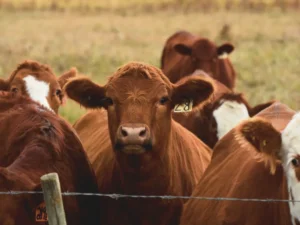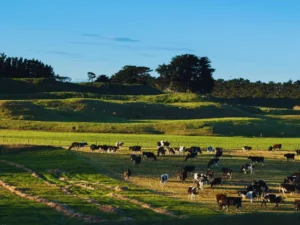Summary
HerdWhistle, a Canadian UHF RFID company, is revolutionizing cattle management by offering an affordable and effective UHF RFID-based system for tracking cattle. The system, designed to provide beef supply chain transparency, has been particularly useful in feedlots where labor shortages and the need for accurate animal monitoring are critical. Through RFID tags, advanced antennas, and multispectral cameras, the technology helps identify cattle, monitor their health, and provide actionable data to improve overall farm efficiency.
The Evolution of RFID in Cattle Management
A Shift from LF to UHF RFID in Livestock Cattle Management
While traditional low-frequency (LF) RFID has long been used in tracking cattle, ultra-high frequency (UHF) RFID systems are offering deeper insights into cattle health, location, and behavior. UHF RFID provides a more detailed view and greater read distances, making it more suitable for large-scale operations like feedlots. However, due to high costs and complex installations, many cattle producers have been hesitant to adopt UHF systems.
HerdWhistle’s Affordable UHF Solution
HerdWhistle has addressed these challenges by developing a cost-effective UHF RFID system designed for the demanding conditions of cattle feedlots. Through a recent partnership with Texas-based Block Trust Network, HerdWhistle is expanding its global reach, providing its UHF RFID readers, antennas, and advanced camera systems to a broader audience. According to Adam Morand, COO of HerdWhistle, the system offers a scalable solution to track cattle health and well-being across diverse environments.
Overcoming Traceability Challenges in Cattle Operations

Addressing Labor Shortages in Feedlots
Feedlots, which manage thousands of cattle, often face labor shortages that make manual tracking systems impractical. Traditionally, LF RFID requires workers to physically touch each tag with a wand reader, which is time-consuming and stressful for the animals. In contrast, UHF RFID systems allow for hands-off monitoring, with tags being read from a distance, reducing the need for physical interaction and streamlining the tracking process.
Automating Visibility in Cattle Feedlots
HerdWhistle was launched in 2019 to automate feedlot monitoring, comparing the process to tracking work-in-progress in manufacturing. By deploying UHF RFID tags on cattle ears and installing antennas at strategic locations such as feeding troughs, the system captures and transmits real-time data on cattle movements, health, and overall status. This automation minimizes loss, improves cattle health management, and increases operational efficiency.
Technological Solutions for Feedlot Challenges
Designing RFID Systems for Harsh Environments
Feedlots present unique environmental challenges for RFID systems, including exposure to water, dirt, and unpredictable animal movements. HerdWhistle developed rugged antennas and readers that withstand these harsh conditions. The RFID antennas, available in different designs such as long panels or coax cables, are capable of reading thousands of cattle tags simultaneously, even in demanding environments like outdoor feedlots.
Handheld RFID Solutions for Targeted Monitoring
HerdWhistle offers handheld RFID readers alongside fixed antennas, including a gun-style reader that reads tags up to 100 feet away. This tool helps locate animals not detected at feeding stations, especially those at risk of illness or injury. Another handheld scanner supports both LF and UHF RFID, ensuring smooth integration of various RFID technologies in one system.
Health Monitoring with Multispectral Imaging

Using Infrared Cameras to Assess Animal Health
One of the most advanced features of HerdWhistle’s system is the BigEye™ multispectral camera, which captures 3D measurements of an animal’s body composition and weight. The infrared sensor in the camera generates real-time thermal images that can identify animals showing early signs of disease. This data links to the animal’s RFID tag, allowing quick identification and intervention to isolate at-risk cattle.
Early Disease Detection and Treatment
The integration of infrared thermography with RFID technology provides a comprehensive tool for early disease detection. Animals identified as “at risk” can be quickly located and moved to hospital pens for treatment, reducing the spread of illness within the herd. This system ensures continuous health monitoring, enabling feedlot managers to make data-driven decisions on vaccinations and antibiotic applications.
Frequently Asked Questions About Cattle Management
- What makes UHF RFID different from LF RFID in cattle management?
UHF RFID offers longer read ranges and the ability to capture more detailed data, while LF RFID requires closer contact and more manual intervention. UHF is particularly useful in large-scale operations such as feedlots.
- How does HerdWhistle’s system improve feedlot operations?
- What role does the BigEye™ multispectral camera play in cattle management?
The BigEye™ camera captures thermal and 3D images of cattle to assess their health and weight in real time. This allows for early detection of illness and more effective management of cattle health.
- Can HerdWhistle’s system be used in other livestock operations?
Yes, the technology works with other livestock, including sheep and pigs, offering similar benefits for health monitoring and operational visibility.
Comparison of LF and UHF RFID for Cattle Monitoring
| Feature | LF RFID | UHF RFID |
| Read Range | Short (requires proximity) | Long (up to 100 feet) |
| Data Capture Method | Manual, labor-intensive | Automated, hands-free |
| Environmental Tolerance | Limited durability in harsh conditions | High durability, designed for outdoor use |
| Cost | Lower initial cost | Higher initial cost, but cost-effective over time |
| Integration | Limited to specific tags | Can integrate with cameras and sensors for health monitoring |
This table shows the benefits of UHF RFID over traditional LF systems, explaining why UHF is now preferred for large-scale cattle operations. With UHF technology, feedlots and livestock producers boost traceability, improve animal health, and increase productivity.
